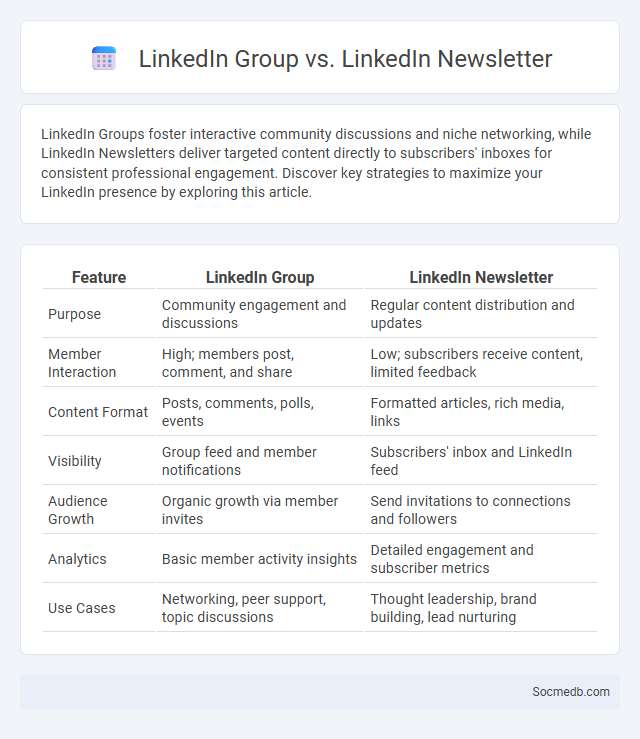
Photo illustration: LinkedIn Group vs LinkedIn Newsletter
LinkedIn Groups foster interactive community discussions and niche networking, while LinkedIn Newsletters deliver targeted content directly to subscribers' inboxes for consistent professional engagement. Discover key strategies to maximize your LinkedIn presence by exploring this article.
Table of Comparison
| Feature | LinkedIn Group | LinkedIn Newsletter |
|---|---|---|
| Purpose | Community engagement and discussions | Regular content distribution and updates |
| Member Interaction | High; members post, comment, and share | Low; subscribers receive content, limited feedback |
| Content Format | Posts, comments, polls, events | Formatted articles, rich media, links |
| Visibility | Group feed and member notifications | Subscribers' inbox and LinkedIn feed |
| Audience Growth | Organic growth via member invites | Send invitations to connections and followers |
| Analytics | Basic member activity insights | Detailed engagement and subscriber metrics |
| Use Cases | Networking, peer support, topic discussions | Thought leadership, brand building, lead nurturing |
Introduction to LinkedIn Groups, Newsletters, and Niche Communities
LinkedIn Groups foster professional networking by connecting users with others in specific industries, enabling targeted discussions and knowledge sharing. Newsletters on LinkedIn allow experts and companies to deliver curated content directly to subscribers, enhancing engagement and thought leadership. Niche communities within LinkedIn provide specialized forums where members exchange insights, opportunities, and trends related to particular professional fields or interests.
Key Features of LinkedIn Groups
LinkedIn Groups offer a collaborative platform where professionals can network, share insights, and discuss industry-specific topics. Key features include targeted discussions, member moderation, and content sharing that foster niche community engagement. These groups enhance professional visibility and enable knowledge exchange within specialized fields.
LinkedIn Newsletters: What Sets Them Apart
LinkedIn Newsletters stand out by enabling professionals to create and distribute personalized content directly to their network's inbox, fostering deeper engagement and consistent communication. This feature leverages LinkedIn's unique professional audience and algorithm to amplify visibility and build authority within specific industries. Your ability to share expert insights and updates regularly helps establish thought leadership and grow a targeted subscriber base efficiently.
Understanding the Power of Niche Communities
Niche communities on social media harness the power of focused engagement, driving higher interaction rates and fostering authentic connections among members. These specialized groups attract targeted audiences with shared interests, increasing content relevance and brand loyalty. Leveraging niche communities enables businesses to tailor marketing strategies, optimize user experience, and amplify reach within specific demographics.
Audience Engagement: Comparing the Platforms
Audience engagement varies significantly across social media platforms, with Instagram and TikTok leading in visual and short-video interactions, while Twitter excels in real-time conversations and trending topics. Facebook offers robust community-building tools and versatile content formats, appealing to a broad demographic, whereas LinkedIn focuses on professional networking and industry-specific discussions that drive meaningful engagement. By analyzing platform-specific engagement metrics, you can tailor your content strategy to maximize interaction and foster a loyal audience.
Content Distribution and Visibility Differences
Content distribution on social media varies significantly across platforms, influencing visibility and audience reach. Algorithms prioritize different types of content; for instance, Instagram favors visual posts and stories, while Twitter emphasizes timely text updates and trending topics. Understanding these distribution mechanisms helps optimize posting strategies to enhance engagement and maximize content visibility.
Networking and Relationship Building Opportunities
Social media platforms provide powerful networking and relationship-building opportunities by connecting professionals across industries and geographic locations. Your online presence can significantly expand your reach, enabling you to engage with potential clients, collaborators, and mentors in real-time. Leveraging features like groups, direct messaging, and content sharing fosters meaningful interactions that strengthen trust and open doors for business growth.
Moderation and Community Management Challenges
Effective social media moderation requires balancing open expression with the need to prevent harmful content such as hate speech, misinformation, and spam, which can undermine community trust. Community management challenges include addressing diverse user behavior, maintaining engagement, and fostering a positive environment to support your brand's reputation. Implementing advanced moderation tools and clear guidelines helps protect user experience while ensuring compliance with platform policies.
Choosing the Best Platform for Your Goals
Selecting the best social media platform depends on your target audience, content type, and engagement goals. Platforms like Instagram and TikTok excel in visual content and younger demographics, while LinkedIn suits B2B networking and professional branding. Understanding each platform's unique algorithms and user behavior helps tailor your strategy for maximum reach and impact.
Conclusion: Which Community Tool Is Right for You?
Choosing the right social media community tool depends on your specific goals, whether it's engagement, content sharing, or analytics. Tools like Facebook Groups excel in fostering interactive discussions, while platforms such as LinkedIn are ideal for professional networking and targeted content distribution. Evaluating features, user demographics, and integration capabilities ensures the selected tool aligns with your community-building objectives effectively.
 socmedb.com
socmedb.com